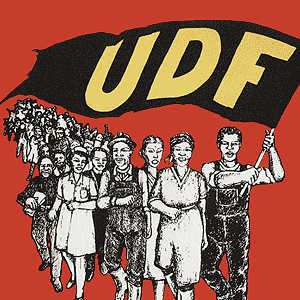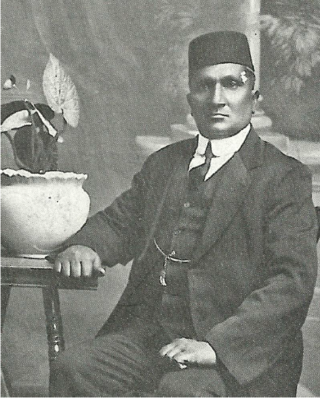
Fatima Meer was a South African writer, academic, screenwriter, and prominent anti-apartheid activist.
Yusuf Mohamed Dadoo OMSG was a South African Communist and an anti-apartheid activist. During his life, he was chair of both the South African Indian Congress and the South African Communist Party, as well as being a major proponent of co-operation between those organisations and the African National Congress. He was a leader of the Defiance Campaign and a defendant at the Treason Trial in 1956. His last days were spent in exile in London, where he is buried at Highgate Cemetery; a few metres away from the Tomb of Karl Marx.

The United Democratic Front (UDF) was a South African popular front that existed from 1983 to 1991. The UDF comprised more than 400 public organizations including trade unions, students' unions, women's and parachurch organizations. The UDF's goal was to establish a "non-racial, united South Africa in which segregation is abolished and in which society is freed from institutional and systematic racism." Its slogan was "UDF Unites, Apartheid Divides." The Front was established in 1983 to oppose the introduction of the Tricameral Parliament by the white-dominated National Party government, and dissolved in 1991 during the early stages of the transition to democracy.
Gangathura Mohambry Naicker was a medical doctor and a South African anti-apartheid activist of Indian Tamil descent.
George Naicker was a prominent South African anti-apartheid activist of Indian Tamil descent. He was one of six sons. His mother died while in prison on Robben Island.

Govindasamy Krishnasamy Thambi Naidoo was a South African civil rights activist. He was an early collaborator of Mahatma Gandhi leading many protests in then South Africa against racial discrimination targeted at the Indian community.

Ela Gandhi, is a South African peace activist and former politician. She served as a Member of Parliament in South Africa from 1994 to 2004, where she aligned with the African National Congress (ANC) party representing the Phoenix area of Inanda in the KwaZulu-Natal province. Her parliamentary committee assignments included the Welfare, and Public Enterprises committees as well as the ad hoc committee on Surrogate Motherhood. She was an alternate member of the Justice Committee and served on Theme Committee 5 on Judiciary and Legal Systems. She is the granddaughter of Mahatma Gandhi.
The South African Indian Congress (SAIC) was an umbrella body founded in 1921 to coordinate between political organisations representing Indians in the various provinces of South Africa. Its members were the Natal Indian Congress (NIC), the Transvaal Indian Congress (TIC), and, initially, the Cape British Indian Council. It advocated non-violent resistance to discriminatory laws and in its formative years was strongly influenced by the NIC's founder, Mahatma Gandhi.

Indian South Africans are South Africans who descend from indentured labourers and free migrants who arrived from British India during the late 1800s and early 1900s. The majority live in and around the city of Durban, making it one of the largest ethnically Indian-populated cities outside of India.
The Transvaal Indian Congress (TIC) was a political organisation established in 1903 to fight discrimination against Indians in the Transvaal Colony, and later the Transvaal Province, of South Africa. Founded in 1903 as the Transvaal British Indian Association, it was a member of the South African Indian Congress alongside its elder and larger sibling, the Natal Indian Congress. It fell dormant after the end of apartheid in 1994.

Internal resistance to apartheid in South Africa originated from several independent sectors of South African society and took forms ranging from social movements and passive resistance to guerrilla warfare. Mass action against the ruling National Party (NP) government, coupled with South Africa's growing international isolation and economic sanctions, were instrumental in leading to negotiations to end apartheid, which began formally in 1990 and ended with South Africa's first multiracial elections under a universal franchise in 1994.
Billy Nair was a South African politician, a member of the National Assembly of South Africa, an anti-apartheid activist and a political prisoner in Robben Island.
Amina Cachalia, OLB was a South African anti-Apartheid activist, women's rights activist, and politician. She was a longtime friend and ally of former President Nelson Mandela. Her late husband was political activist Yusuf Cachalia.

Kesaveloo Goonam, also known as Kesaveloo Goonaruthnum Naidoo (1906–1998) was a South African doctor and anti-apartheid activist. She was also called "Coolie Doctor", which became the title of her 1991 autobiography.
Dr. Zainab Asvat was a South African anti-apartheid activist. Asvat was trained as a medical doctor, but was politically active most of her life.
The Pietermaritzburg Treason Trial was heard in the Supreme Court of South Africa from 21 October 1985 to 23 June 1986. In the largest political trial since the Rivonia Trial, the apartheid state pursued charges of high treason against 16 leaders of the United Democratic Front (UDF) and four affiliated organisations. State v Ramgobin and Others was generally regarded as a failure in both legal and political terms: the charges against 12 defendants were dropped in December 1985 and the remaining four were freed in June 1986, while the South African state received international criticism for having instituted the charges in the first place.
Mawalal "Mewa" Ramgobin was a South African politician and former anti-apartheid activist. A stalwart of the Natal Indian Congress, he represented the African National Congress (ANC) in the National Assembly from 1994 to 2009.
Rashid Ahmed Mahmood "Ram" Salojee, often misspelled Ram Saloojee, was a South African politician, medical doctor, and former anti-apartheid activist. Between 1994 and 2009, he represented the African National Congress (ANC) in the Gauteng Provincial Legislature and both houses of Parliament.
Muzivukile Curnick Ndlovu, also spelled Muzuvukile, was a South African politician, anti-apartheid activist, and trade unionist. A veteran of the African National Congress, he represented the party in the National Assembly during the first democratic Parliament from 1994 to 1999. He was also a former national chairperson of the United Democratic Front, a former secretary of the Railway and Harbour Workers' Union, and a former regional commander of Umkhonto we Sizwe (MK) in Natal Province.
Amina PahadOLS was a South African anti-apartheid activist. A member of the Transvaal Indian Congress, she rose to prominence for her role in passive resistance against the Asiatic Land Tenure and Indian Representation Act of 1946. She was also known as the matriarch of the Pahad family's politically active home in Johannesburg.










